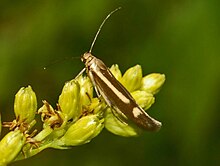| Scythris | |
|---|---|

| |
| Imago of Scythris heinemanni at Cerreto Ratti in Borghetto di Borbera, Italy | |
| Scientific classification | |
| Domain: | Eukaryota |
| Kingdom: | Animalia |
| Phylum: | Arthropoda |
| Class: | Insecta |
| Order: | Lepidoptera |
| Family: | Scythrididae |
| Genus: | Scythris Hübner, |
| Type species | |
| Tinea chenopodiella Hübner, | |
| Species | |
|
Numerous, see text | |
| Synonyms | |
| |
Scythris is a genus of gelechioid moths. It is the type genus of the flower moth family, which is sometimes included as a subfamily in the Xyloryctidae, or together with these merged into the Oecophoridae. The genus was erected by Jacob Hübner in 1825.
It is the largest genus of flower moths, and as such might not be fully monophyletic with regard to some very small or monotypic genera placed in the same family. In addition, new species of Scythris continue to be discovered and described.
Selected species
Species groups
The species of Scythris have been divided among several groups, which may or may not be monophyletic; those that are may – provided they are closely enough related to the type species S. limbella – be considered subgenera. There is a considerable number of species whose exact relationships are hitherto elusive. Some have been placed in a "monospecific species group" of their own, as they are too distinct from the other groups to be included there, yet at the same time have characteristic autapomorphies. Species groups include:
|
aenea group
aerariella group
alseriella group
Australian group
bagdadiella group
bazaensis group
boseanella group
camelella group
canescens group
caramani group
cicadella group
cistorum group
crassiuscula group
crypta group
decrepidella group
dissitella group
elenae group
empetrella group
fallacella group
|
formicella group
fuscoaenea group
fuscopterella group
gobiensis group
grandipennis group
gravatella group
iagella group
inclusella group
inertella group
inspersella group
insulella ("ericivorella") group
karinae group
karsholti group
klimeschi group
knochella group
laminella group
limbella group – possibly subgenus Scythris
lobella group
mariannae group
martini group
meanderis group
monochreella group
mus group
nigrella group
nipholecta group
noricella group
obscurella group – possibly subgenus Galanthia
palustris group
|
pascuella group
passerini group
penicillata group
petrella group
picaepennis group
pinker group
platypyga group
podoliensis group
polycarpaeae group
productella group
pulicella group
punctivittella group
rubioi group
schleichiella group
scopolella group
seliniella group
siccella group
sinensis group
subfasciata group
tributella group
unquisella group
? species group
|
Species incertae sedis
Finally, there are many species which are neither clearly assignable to any one species group, nor autapomorphic enough to be included in a monospecific "group". These include:
Afrotropical
Selected former species
|
|
|
Footnotes
- AEBR (2008), and see references in Savela (2008)
- Pitkin & Jenkins (2004), AEBR (2008), ToL (2008), FE (2009), and see references in Savela (2008)
- ^ FE (2009), and see references in Savela (2008)
- AEBR (2008), FE (2009), and see references in Savela (2008)
References
- Australian Biological Resources Study (ABRS) (2008): Australian Faunal Directory – Scythris. Version of 9 October 2008. Retrieved 1 May 2010.
- Fauna Europaea (FE) (2009): Scythris. Version 2.1, 22 December 2009. Retrieved 1 May 2010.
- Pitkin, Brian & Jenkins, Paul (2004): Butterflies and Moths of the World, Generic Names and their Type-species – Scythris. Version of 5 November 2004. Retrieved 1 May 2010.
- Savela, Markku (2008): Markku Savela's Lepidoptera and some other life forms – Scythris. Version of 17 July 2008. Retrieved 1 May 2010.
- Tree of Life Web Project (ToL) (2009): Xyloryctidae. Version of 1 May 2008. Retrieved 30 April 2010.